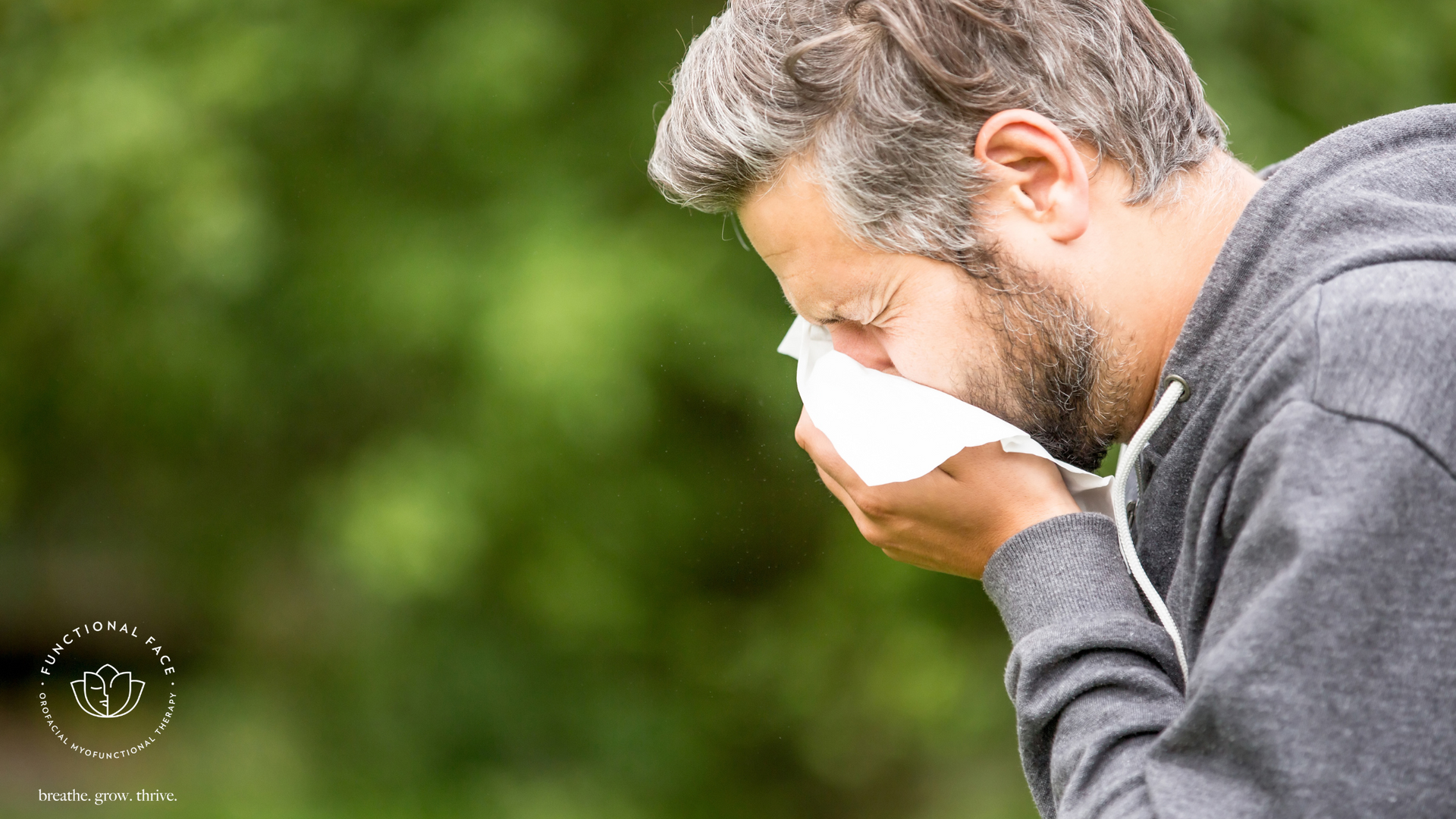Understanding the hidden effects of allergies on oral function, facial growth, and airway health.

Most people think of allergies as seasonal annoyances—runny noses, itchy eyes, maybe a box of tissues on standby. But for many children and adults, allergies can have far-reaching effects that go well beyond sneezing. Chronic nasal congestion can quietly disrupt sleep, change breathing patterns, and contribute to long-term issues with jaw development, facial growth, and even TMJ dysfunction.
Over the years, I’ve worked with clients of all ages who’ve been told they “just have allergies,” when in fact, those allergies are impacting their entire airway system—sometimes without them realizing it. Let’s look at how this connection works and why it matters for both kids and adults.
The Allergy–Airway Connection: What Happens When the Nose Doesn’t Work
When someone struggles to breathe through their nose due to allergies—whether from environmental triggers, food sensitivities, or chronic sinus inflammation—they often resort to mouth breathing. While that might seem like a harmless backup plan, it sets off a cascade of changes in how the face, jaw, and airway function.
In children, this compensation can interfere with normal craniofacial development:
- Narrowed upper jaw (maxilla)
- Elongated face shape
- Forward head posture
- Crowded teeth or poor bite alignment
- Delayed speech or articulation issues
In adults, long-term mouth breathing can contribute to:
- TMJ disorders
- Head and neck tension
- Sleep-disordered breathing or obstructive sleep apnea
- Dry mouth, cavities, and gum disease
- Poor sleep quality, fatigue, and brain fog
👉 Learn more: Six Harmful Consequences of Mouth Breathing- And What To Do About It
📖 “The persistence of nasal obstruction during critical growth periods can lead to changes in craniofacial morphology and breathing patterns, often extending into adulthood.”
—Harari et al., AJODO, 2010
Why Tongue Posture Suffers (And Why That Matters)
Whether you’re 5 or 55, your tongue posture plays a vital role in your health. Ideally, the tongue should rest against the roof of the mouth, creating gentle pressure that helps shape the palate, support the airway, and guide proper swallowing.
Allergies often cause:
- The tongue to drop low in the mouth
- Open-mouth rest posture
- Dysfunctional swallowing (sometimes called tongue thrust)
- A habit of mouth breathing that persists even when congestion improves
For kids, this can impact how their face and airway grow. For adults, it can lead to sleep apnea, clenching or grinding, TMJ pain, and upper airway collapse during sleep.
Sleep, Snoring & Fatigue: How Allergies Sabotage Rest at Every Age
Chronic nasal inflammation makes it harder to maintain nasal breathing overnight. That’s why many people with allergies experience:
- Nighttime mouth breathing or snoring
- Teeth grinding
- Restless sleep
- Waking up feeling tired, foggy, or with a dry mouth
- In children, behavioral issues like irritability, hyperactivity, or difficulty focusing
Adults often chalk these issues up to aging or stress. Kids are often misdiagnosed with ADHD. But poor sleep caused by airway compromise is often the real culprit.
What You Can Do (At Any Age)
1. Treat the root of the allergies.
Work with your doctor or allergist to identify and manage the triggers—dust mites, pollen, food sensitivities, or mold. Conventional treatments like antihistamines, nasal sprays, or sublingual immunotherapy may be helpful—but you don’t have to stop there.
Many families also explore natural options to support the body’s inflammatory response and immune balance, including:
- Quercetin – a plant compound with natural antihistamine and anti-inflammatory properties
- Bromelain – an enzyme found in pineapple that may enhance the effects of quercetin and reduce sinus swelling
- Stinging nettle – sometimes used to calm allergy symptoms naturally
- Vitamin C – helps stabilize mast cells and reduce histamine levels
- Saline nasal rinses – to flush allergens and open the nasal airway
- HEPA air purifiers – especially in bedrooms to reduce airborne irritants
(As always, consult your healthcare provider before starting any supplements, especially for children or individuals with health conditions.)
2. Restore nasal breathing.
Breathing through your nose isn’t just ideal—it’s essential for healthy oxygen delivery, nitric oxide production, and oral development. If congestion has forced you (or your child) into a habit of mouth breathing, that pattern often sticks—long after the allergy flare has passed.
This is where myofunctional therapy comes in. We work to retrain the tongue, lips, and muscles of the face to support proper breathing and function—so your airway can work the way it was designed to.
Looking at the Big Picture
Whether you're 4, 14, or 40, chronic allergies are not just a comfort issue—they can impact how you breathe, how you sleep, how your face develops, and how your jaw functions. And it’s not just about congestion—it's about the compensation patterns that develop when your airway isn’t working as it should.
If you or your child struggles with allergies, snoring, fatigue, or jaw tension, addressing the root cause and the functional patterns is key to long-term relief.
Want to explore how allergies might be affecting your health, sleep, or facial development? Click here to schedule a consultation or an evaluation.











